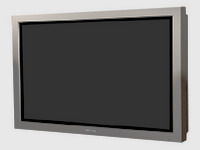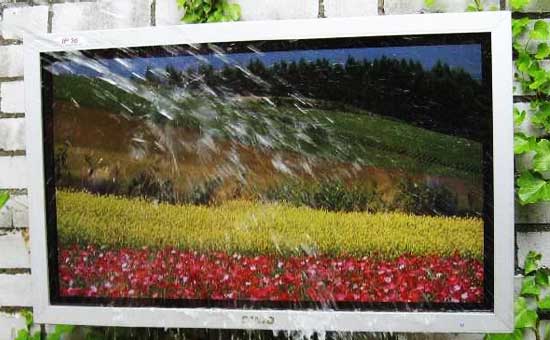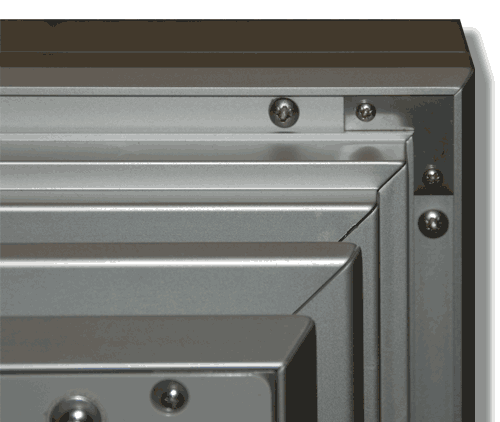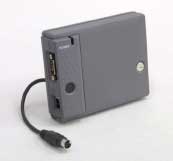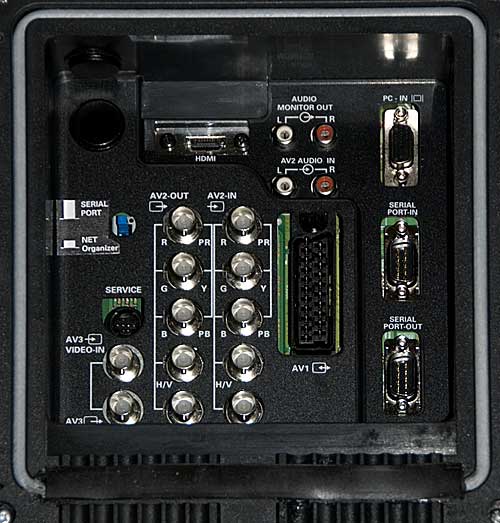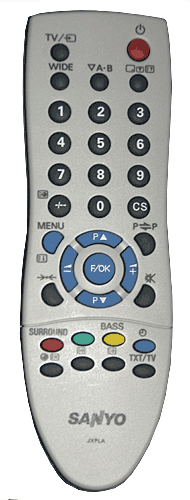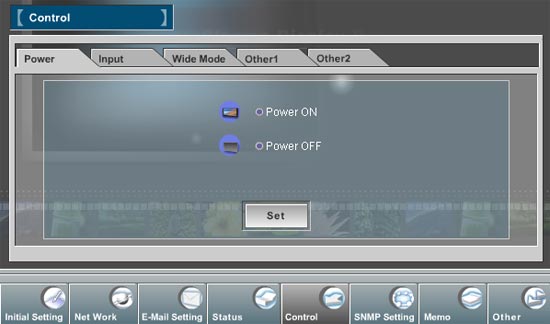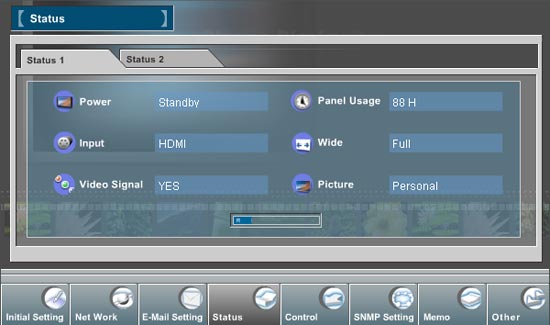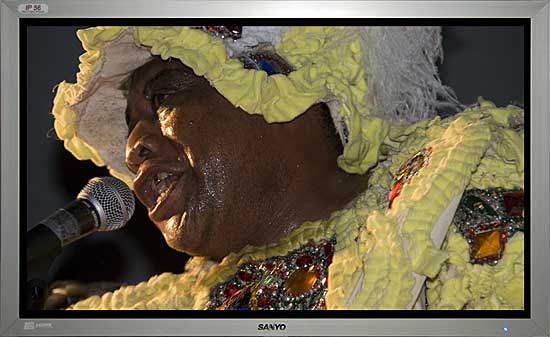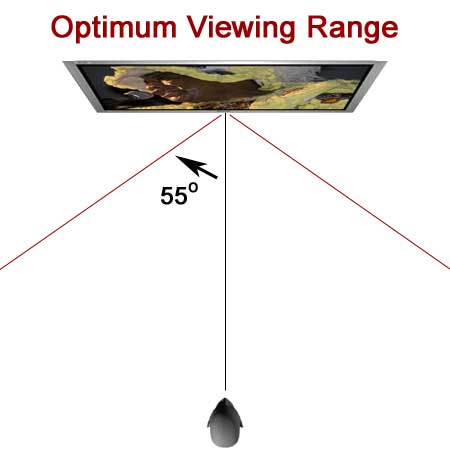
|
|
 |

|


Dick De Jong March 30, 2007 HDTV Solutions Considering the deluge of rain that we are experiencing today, it seems appropriate that we are reviewing an IP56 certified TV. That rating means that the Sanyo 42LM4WPN can withstand at least 65 gallons per minute of water from a one inch nozzle delivered from a distance not less than ten feet for five minutes. Simply stated, this Sanyo is waterproof. We decided not to test it outside in the thunderstorm today, but we are convinced that this 42" LCD encased in its aluminum frame and tamper-resistant glass would stay high and dry. Once the novelty of reviewing a weatherproof TV faded, we discovered a much more important characteristic about the 42LM4WPN. It delivers one of the best pictures that we have seen in a 720p TV, (native resolution of 1366 x 768). The color rendition, especially with skin tones, was consistently top notch. And we're tough judges on skin tone fidelity. Of course with a sticker price of almost $8500, this unit is aimed more at commercial applications such as outdoor digital signage. But if you are planning a home theater/pub in your basement or a swim-in screen in your backyard, then put this Sanyo on your short list. As we were finishing this review, Ted (Tatsuya) Shikai at Sanyo informed us that this unit comes in two different configurations. In Europe, it includes a TV tuner. For the U.S. market, no tuner, (neither NTSC nor ATSC), is provided, which makes the 42LM4WPN that we tested a monitor. If you wish to watch TV on this unit, you need to subscribe to cable or satellite services and use their set-top box to change channels. Also the Sanyo does not have integrated speakers. If you need sound, you will require a separate audio system. Not ideal for many casual TV watchers, but then again, at $8500, this monitor is not really marketed for the casual viewer. Though in reality, many HD fans already have cable TV and home theater audio systems. Out of the Box
As you can see, with its brushed aluminum enclosure, this Sanyo is not your typical looking black bezeled HDTV, which we find refreshing. Though if you peak around the metal edge, you'll discover that familiar black frame surrounding the LCD inside. This is after all, a TV ensconced in a waterproof casing, albeit, a very stylish one. Since this is a monitor with no speakers attached, the design is streamlined with a simple Sanyo logo in the middle of the frame and a blue power light on the right. The control buttons, (waterproof, of course), are pointed down on the bottom right. The sides of the aluminum case extend backwards in a notable Ziggurat fashion that may never be appreciated if this 6.5 inch deep, sleek but sturdy monitor is wall mounted.
On the back of the enclosure are two panels. The upper one is for the optional PJ-Net device, which, when attached, allows you to control the display properties of the monitor using your Internet browser without any additional software. The PJNet box was not included with the review unit, so we did not have the opportunity to test its capabilities.
The lower panel contains all the audio, video and PC connections, but not in the form that most consumers are familiar with. The diverse types of connectors reflect the industrial and international nature of this monitor. For example, the Component In and Out plugs are not the standard RCAs, but rather BNCs. Even then the connectors do double duty serving both as Y, Pb, Pr terminals and as RGB, H/V inputs for a PC. As an alternative, a VGA In, (15 pin D-Sub), is included. Also on the PC side, 9 pin RS232C In and Out ports are provided for receiving external commands. Of course, there's an HDMI plug and stereo RCA Audio Ins and Monitor Audio Outs, and a Composite Video In and Out, (BNC type). Since this is a monitor, there are no RF inputs for antennas.
And finally, next to the two Component sets, is an odd duck - at least to us Yanks - connector called SCART. For those Americans who never hooked up a VCR in Europe, the Scart (Syndicat des Constructeurs d'Appareils Radiorécepteurs et Téléviseurs) 21-pin connector combines audio and video. Also known as a Pertitel connector or Euroconnector, a SCART is common on many television sets in Europe and other locales that have adopted the PAL video standard. Being NTSC blokes on this side of the pond, we don't have any Scart gear so we didn't have a chance to test the Scart feature. To waterproof the panel requires a little design ingenuity, flexible cables, a rubber gasket and a screw-on cover. But even though the cover allows for a bit of breathing room, some cables with bulky ends, like our VGA, are a tight fit. In fact, we couldn't screw down the cover snugly with the VGA plugged in.
As a digital signage monitor, the need for picture-in-picture features integrated into the unit are not necessary. Couple that with the fact that no TV tuners means no messing about with channel scanning or V chips or parental controls and setup is a breeze. Also, the non-backlit remote control is thankfully less cluttered. Though there are numbered buttons for changing channels and a group of alien audio buttons on the bottom that are indications that the same remote is used for the European model that includes a tuner. We would have preferred that the audio buttons had been reprogrammed to directly access the different Input options. Instead, you have to scroll through them with the TV key. Setup When you attach an HDMI or Component input, the Picture Menu is limited to Brightness, Contrast, Color (Saturation), and Sharpness. Surprisingly, neither Hue (Tint) nor Color Temperature controls are provided. Usually we would be howling for this lack of tweaks; but as we mentioned, the color was so consistently spot on that we didn't mind. Also, considering that the Menu, which takes up the top third of the screen, would not minimize when you were adjusting a setting, we were happy not to have to spend much time fine tuning. With the VGA input, the Picture Menu expands to offering individual Red, Green, and Blue sliders for what Sanyo calls White Tone control. We found that you could really mangle your color with these powerful tools. And since the color was so good to begin with and there is no Reset to Default button, we would almost prefer not to have these controls. We say almost. We would rather have them then not. Just tread softly if you need to use them. Actually, the manual showed another version of the Picture Menu, which we finally tracked down as the one you see when you have a Composite input, (and as Sakai informed us, with Scart sources). Since we never test with a Composite video source, we had almost blotted from our memories how horrible composite video can look. Even with the added adjustments for Noise Reduction, Dynamic Skin Tones, and Text Brightness, the composite picture still looked like a video version of the 7th Circle of Dante's Inferno - or more graphically, like crap. But let us reiterate, if you feed the 42LM4WPN a nice 720p signal, the picture is one of the best looking that we have had the pleasure to watch. Recently, we have been running our review units through their paces with a DVD full of video processing tests like jaggies and noise reduction. This HQV disc is produced by Silicon Optix, who makes their own brand of video processing chips. Even so, we find that the DVD offers some good tests that we can use to compare TVs. One interesting fact about the setup is that you need to find a DVD player that outputs 480i, which is not that easy in these days of upconverting and deinterlacing players. Luckily, we have a Samsung PV-421 that can output a 480i signal through Component cables. The Sanyo did not fare so well on the jaggies or the dynamic motion tests. We have seen better results from other TVs. But as we have mentioned before, rarely do you ever feed 480i signals to your HDTV unless you are capturing over-the-air channels. Most cable boxes and DVD players feed out at least a 480p signal, if not a 720p. Before we move on, a word or two about the PJ-Net Organizer. We received this little box after the initial review was completed. We approached testing with a bit of trepidation since our previous experience with a network controller - from another manufacturer - was painful. The Sanyo rep, Ted Shakai assured us that the PJ-Net was easy to use and by golly, he was right. As a matter of fact, the manual we initially received with the product was the wrong one and we were still able to get the unit up and running. Installation of the PJ-Net box was as simple as plugging it into its connector on the back of the TV and fastening it with screws. The unit receives its power from the TV interface. We then attached it with a cable to our router. Once we discovered that we had to flip a switch on the back of the TV, we were ready to communicate with PJ-Net from our computer through an Internet browser. We used Firefox. We simply typed in a default IP address and our computer was talking to the PJ-Net Organizer through software that loaded from the unit. The functions provided in the menu are pretty basic. For example, in the Control menu, you can turn the Power On or Off, but there's no ability in the menu to set a timer. Likewise, you can change the Input source from HDMI to Component, but there is no way to program the change.
We would assume that since the PJ-Net box also has an RS-232c port on it that you could design software that talks to the unit and would give you greater control over the Sanyo monitor. That software is just not part of the PJ-Net package.
One of the main functions of the Organizer interface is monitoring the status of the 42LM4WPN. In the Status menu, you can check on items like whether the Power is on, what the current Input source is and Panel Usage hours. In the Email Settings menu, you can arrange to have email alerts sent to you if the power fails or if the panel usage hits a certain number of hours. Performance Now, this is not a 1080p monitor. If you are a sharp, fine lines type of viewer, this 720p Sanyo does not deliver the detail that you would expect at 1080p. But did we mention the color? In our corner of the viewing world, it's color first and detail a close second. Of course, if you are watching a B&W classic like Casablanca, then it's a tight race between contrast and detail. For those of you who are so addicted to games that you can't loosen your grip on the controller even when you are in the shower, this waterproof monitor rendered Games of War in all of its blood splattered glory from our Xbox 360. Perhaps a better gauge for a digital signage unit is how it performs with imagery from a PC. So we hooked up a Dell laptop using a VGA cable and opened up Photoshop to view a few SXSW photos. We set the resolution on the laptop to 1280 x 768 and adjusted the picture a tad on the Horizontal and Vertical. The quality of the images was stunning. We could easily imagine an outdoor digital signage display at the mall of Victoria's Secret or Calvin Klein models.
Finally, the viewing angle on the 42LM4WPN was respectable for an LCD. Interestingly, as you strayed farther away from perpendicular, the image became darker. Often with LCDs, the picture becomes washed out. Sanyo rates this monitor's viewing angle at 178 degrees, which means 89 degrees each way off perpendicular. Even though at these severe wide angles, the image was watchable; for best viewing, we would suggest that you sit closer to the center.
Now you might think that the tamper-resistant glass in the outer case may add an additional glare. But Sanyo describes this glass as approximately 1/10 less reflective and five times tougher than the usual float glass. In practical terms, the only glare we see is at wide viewing angles and it is neglible. Conclusion
Star Ratings Second, we have given only two 5 Star ratings, which we reserve for truly outstanding accomplishment. Performance: 4.5 Features: 4.5 Ease of Use: 4.0 Value: 4 |
Bookmark:
![]() del.icio.us
del.icio.us
![]() Reddit
Reddit
![]() Google
Google
| Send this Page | Print this Page | Report Errors |




